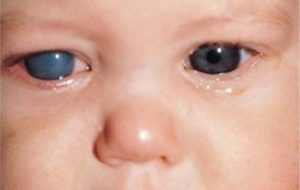Congenital glaucoma is a rare but serious eye condition that can affect vision from the earliest days of life. Early diagnosis is crucial to ensure timely and appropriate treatment, thus protecting the vision of the little ones. In this article, we will explore the causes, symptoms and treatment options available and, with clear and straightforward information, aim to provide useful support for parents, caregivers and anyone wishing to learn more about this condition.
What Congenital Glaucoma Means
The congenital glaucoma is a disorder present from birth, characterised by increased intraocular pressure, which can lead to irreversible damage to the optic nerve and loss of vision if not treated promptly.
Congenital glaucoma is rare: its prevalence is estimated at approximately 1 case per 10,000-18,000 births and is, however, the most common form of childhood glaucoma
The male sex is more often affected than the female (ratio of approximately 3:2). In 70-80% of patients, the disease is bilateral.
In approximately 80% of patients, the diagnosis is made in the first year of life.
Symptoms
The classic triad of symptoms includes:
- epiphora
- blepharospasm
- photophobia
 Children present with reddened eyes with abundant tearing, opaque corneas and enlargement of the eye, secondary to elongation of the eye during development due to high intraocular pressure.
Children present with reddened eyes with abundant tearing, opaque corneas and enlargement of the eye, secondary to elongation of the eye during development due to high intraocular pressure.
Children over the age of 3 years tend to develop progressive myopia and progressive visual field loss.
Signals Not to Be Ignored
Recognising the symptoms of congenital glaucoma is crucial for early diagnosis.
Many parents, unfortunately, are unaware that symptoms can appear in the first months of life. Therefore, it is essential to be informed and vigilant and to pay attention to signs that may be related to this pathology:
- Teary eyesExcessive tearing may indicate eye pressure problems.
- Sensitivity to light: A child who avoids light may have a serious eye problem.
Not ignoring these symptoms can make the difference between healthy vision and permanent eye problems.
Aetiology
Anatomo-pathological causes
The aetiology of congenital glaucoma is unknown, but it appears that the obstruction of aqueous humour outflow occurs at the level of the irido-corneal angle and the trabecular meshwork.
Genetic causes
Genetic mapping of families in which multiple cases of congenital glaucoma occurred identified three chromosomal loci, GLC3A in 2p22.2, GLC3B in 1p36 and GLC3C in 14q24.3-q31.1; the gene CYP1B1 (2p22.2) changed to the GLC3A.
Mutations have also been found in the genes LTBP2 (14q24.3) and MYOC (1q23-q24).
Common Risk Factors
There are several risk factors for congenital glaucoma, of which parents should be aware.
- Prenatal abnormalities: Certain anatomical defects at the level of the irido-corneal angle and the trabecular meshwork may increase the risk.
- Genetics: Family history plays a significant role in the development of this condition since most cases of congenital glaucoma are sporadic in nature, but in 10% patients, autosomal recessive transmission is observed, with variable penetrance. In this case, genetic counselling is recommended for parents carrying the pathogenic mutation, to inform them of the likelihood of 25% to transmit the disease to their offspring
Being aware of risk factors can help parents closely monitor their children's ocular health.
Importance of Early Diagnosis
Diagnosing congenital glaucoma early can make a big difference. Early treatment can preserve vision and improve the child's quality of life.
Regular eye examinations are essential for infants exposed to risk factors.
Diagnostic methods
The diagnosis is based on the complete ophthalmological examination, which shows an opacity of the cornea, which has increased size, the presence of Haab's striae, an increased intraocular pressure (IOP; values >20 mmHg or an asymmetry >5 mmHg), a deep anterior chamber, the insertion of the iris in an excessively high position, a poorly developed scleral spur (by gonioscopy), an increase in the excavation-papilla ratio of the optic nerve head, and a refractive index showing myopia and astigmatism are worrying. When necessary, the examination is performed under anaesthesia.
Differential diagnosis
The differential diagnosis for reddened eyes with profuse tearing arises with nasolacrimal duct obstruction, conjunctivitis, corneal abrasion and uveitis, while for corneal enlargement high axial myopia and megalocornea must be excluded. The differential diagnosis for corneal opacity and oedema arises with congenital corneal dystrophies, birth trauma, keratitis, congenital ocular anomalies and deposition diseases, while for optic nerve excavation it arises with physiological optic nerve excavation, optic papilla coloboma, genetic optic atrophy and optic nerve hypoplasia.
Prenatal diagnosis
Prenatal diagnosis makes it possible to determine the probability of developing the disease in families with known mutations.
Available Treatments
Le treatment options for congenital glaucoma vary depending on the severity of the condition. Knowing these options helps you make informed decisions.
- Surgeryoften necessary to reduce eye pressure.
- Drug therapyused to lower intraocular pressure, manage symptoms and prevent further damage.
- Continuous monitoringindispensable for adapting the treatment to the child's needs.
Each option has its advantages and risks, and a consultation with a specialist is essential to choose the right path.
Continuous Management and Support
Managing congenital glaucoma requires continuous effort. This section explores how to adapt daily life and the support available to families, ensuring a better quality of life for children with this condition.
Adaptations in Daily Life
 The adaptations in daily life are crucial to the well-being of children with congenital glaucoma. These changes can improve their quality of life and reduce the risk of further complications.
The adaptations in daily life are crucial to the well-being of children with congenital glaucoma. These changes can improve their quality of life and reduce the risk of further complications.
- Corrective lensesThey may be necessary to improve eyesight.
- Environmental changesFor example, reduce exposure to bright light in the middle of the day.
- Educational supportEnsure that teachers are aware of the pathology the child is suffering from.
Implementing these adaptations can significantly improve the child's quality of life.
Support for Families
Families of children with congenital glaucoma need ongoing support. Having access to appropriate resources can make a big difference in their journey.
- Support groupsThey provide a context in which experiences and advice can be shared.
- Psychological counselling: Helps to manage stress and anxieties.
- Continuing Education: Provides up-to-date information on the management of glaucomatous disease.
Appropriate support can help families face daily challenges with greater confidence.
Future Perspectives and Innovations
The future of congenital glaucoma treatment is promising. In this section, we will review innovations in research and hopes for further improving the management of this condition.
The research and development in the field of congenital glaucoma is crucial for discovering new therapies and improving existing ones. Technological innovations offer new hope.
- New surgical techniquespromise to be less and less invasive.
- Genetic therapiesare potential treatments to address the root cause.
- Continuous study: Important for a better understanding of the disease.
The hopes for the future of congenital glaucoma treatment are encouraging. With continued research and innovation, there are positive prospects on the horizon.
- Improving care: More effective and less invasive therapies.
- AccessibilityMore accessible care globally.
- Prevention: Better diagnostic tools to prevent disease progression.
Prognosis of congenital glaucoma
The prognosis of congenital glaucoma depends to a large extent on the age at onset: as repeatedly emphasised, early diagnosis and timely surgical treatment significantly influence the child's visual function.
Most patients successfully treated in early childhood have good pressure control, stable optic nerves and a fully functional visual field in adulthood.
In paediatric ophthalmology see also:
- Paediatric cataracts: what you need to know - Oculista Italiano
- Treatment of neonatal chlamydia conjunctivitis - Oculista Italiano
- Bitrian E, Lee RH, Grajewski AL Epidemiology and classification of childhood glaucoma. In: El Sayed YM, Elhusseiny AM, editors. Childhood glaucoma: current trends and future prospects. Cham: Springer International Publishing; 2024. pp. 3-8
- Elhusseiny AM, Haseeb A, Eleiwa TK, et al. A Comparative Study of Ocular Surface Disease in Childhood Glaucoma. Cornea. 2025 Jan 1;44(1):73-79. doi: 10.1097/ICO.0000000000003684. Epub 2024 Sep 20. PMID: 39312704.
